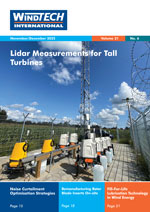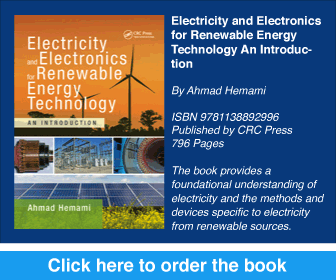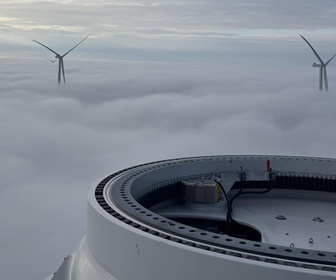- Category: Articles
Constant Speed Turbines on a Grid with Variable Frequency
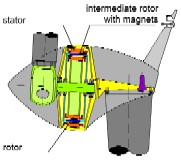 A critical property of an offshore wind turbine is its reliability. The concept presented here aims to improve turbine reliability via the use of a permanent magnet induction machine. This allows the gearbox and converter to be abandoned, thereby reducing the total number of parts. To adapt the rotation speed to the wind speed, a new control concept with just one central converter is used to control the frequency of the park grid. At partial load a maximum power point control is applied to find the optimal frequency. Active stall and pitch control have been investigated at rated load.
A critical property of an offshore wind turbine is its reliability. The concept presented here aims to improve turbine reliability via the use of a permanent magnet induction machine. This allows the gearbox and converter to be abandoned, thereby reducing the total number of parts. To adapt the rotation speed to the wind speed, a new control concept with just one central converter is used to control the frequency of the park grid. At partial load a maximum power point control is applied to find the optimal frequency. Active stall and pitch control have been investigated at rated load.By Eckehard Tröster, Technische Universität Darmstadt, Germany
- Category: Articles
Offshore Resource Assessment Using a Mesoscale Model and GIS
 The grid integration of wind energy is an important issue in Japan. Offshore wind development is likely to play an important role in overcoming the limitations of the grid integration of wind energy. This article describes the results from a joint research project by Tokyo Electric Power Company (TEPCO) and the University of Tokyo, including wind resource assessment using a mesoscale meteorological model and a geographical information system (GIS).
The grid integration of wind energy is an important issue in Japan. Offshore wind development is likely to play an important role in overcoming the limitations of the grid integration of wind energy. This article describes the results from a joint research project by Tokyo Electric Power Company (TEPCO) and the University of Tokyo, including wind resource assessment using a mesoscale meteorological model and a geographical information system (GIS).By Takeshi Ishihara and Atsushi Yamaguchi, University of Tokyo, Japan
- Category: Articles
A Foundation Concept for Offshore Wind Farms
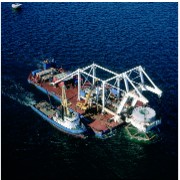 Steel monopile foundations dominate in today’s offshore wind business. ENERGI E2 has a long track record in offshore wind and has worked with concrete gravity foundations as well as steel monopiles. The costs of the main structure of steel monopiles are more than twice as high as those of concrete gravity foundations. Installation of the two types of foundation is likely to be in the same cost range – which would mean that the total cost of concrete gravity foundations should be lower than that of monopile foundations. The very low cost of the concrete foundations for Nysted Offshore Wind Farm illustrate this. It also seems that in the North Sea concrete gravity foundations are more cost effective. Concrete gravity would seem to have potential to become the future foundation concept for offshore wind, and ENERGI E2 intends to exploit the potential of using these foundations.
Steel monopile foundations dominate in today’s offshore wind business. ENERGI E2 has a long track record in offshore wind and has worked with concrete gravity foundations as well as steel monopiles. The costs of the main structure of steel monopiles are more than twice as high as those of concrete gravity foundations. Installation of the two types of foundation is likely to be in the same cost range – which would mean that the total cost of concrete gravity foundations should be lower than that of monopile foundations. The very low cost of the concrete foundations for Nysted Offshore Wind Farm illustrate this. It also seems that in the North Sea concrete gravity foundations are more cost effective. Concrete gravity would seem to have potential to become the future foundation concept for offshore wind, and ENERGI E2 intends to exploit the potential of using these foundations.By Per Vølund, ENERGI E2 A/S, Denmark
- Category: Articles
Intensified Cooperation Leads to Optimised Wind Turbines
 The very large growth of wind turbines during the last 20 years has led to a significant increase in some component prices. The need to meet the strong pressures to deliver electricity from wind as cheaply as possible has resulted in a very close cooperation between turbine and blade developers. The generic blades of the past have almost totally disappeared. This article describes some of the resulting effects in terms of more efficient material use and the design criteria at the interface between blade and turbine design (which cannot be optimised from just one side). This design integration is essential for smaller or start-up turbine manufacturers in order to enable them to survive in a market that is more and more dominated by ‘all-in-one-house’ global players.
The very large growth of wind turbines during the last 20 years has led to a significant increase in some component prices. The need to meet the strong pressures to deliver electricity from wind as cheaply as possible has resulted in a very close cooperation between turbine and blade developers. The generic blades of the past have almost totally disappeared. This article describes some of the resulting effects in terms of more efficient material use and the design criteria at the interface between blade and turbine design (which cannot be optimised from just one side). This design integration is essential for smaller or start-up turbine manufacturers in order to enable them to survive in a market that is more and more dominated by ‘all-in-one-house’ global players.By Roland Stoer, EUROS Entwicklungsgesellschaft für Windkraftanlagen mbH, Germany
- Category: Articles
Internet Services for Planning Distributed Generation Connections
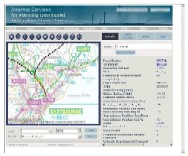 How do you quickly evaluate the capacity of the distribution network to accept a new generation site? This article describes a software development project that provides information on the UK electrical distribution system and offers an initial assessment service for connection of generation plant. The information is presented on a map background and in automatically generated reports, and it is made available on a website.
How do you quickly evaluate the capacity of the distribution network to accept a new generation site? This article describes a software development project that provides information on the UK electrical distribution system and offers an initial assessment service for connection of generation plant. The information is presented on a map background and in automatically generated reports, and it is made available on a website.By Christine Barbier, Peter Reay and Victoria Gosling, Econnect Ltd, UK, and Dave Curry and Angela Morgan, Imass Ltd, UK
- Category: Articles
Finance Supporting Mechanisms to Contribute to a Diversified Renewable Energy Strategy
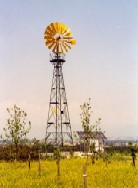 While the market for large wind turbines is almost entirely concentrated in the in-feed of electricity into national grids, small wind turbines (up to 100kW) present a vast range of market opportunities (e.g. in offshore areas, rural areas, private farms or mobile applications). Also in some industrial sector applications small wind turbines are cutting load peaks in times of high energy demand and/or have a green marketing function. Thus, the deployment of a significantly increased number of installations of small wind turbines could have an important impact on the penetration of wind energy and in the renewable energy mix.
While the market for large wind turbines is almost entirely concentrated in the in-feed of electricity into national grids, small wind turbines (up to 100kW) present a vast range of market opportunities (e.g. in offshore areas, rural areas, private farms or mobile applications). Also in some industrial sector applications small wind turbines are cutting load peaks in times of high energy demand and/or have a green marketing function. Thus, the deployment of a significantly increased number of installations of small wind turbines could have an important impact on the penetration of wind energy and in the renewable energy mix.By Rosa M. Tarragó, Molins de Vent Tarragó, Spain and Andreas Wiese, Lahmeyer International GmbH, Germany
- How Reliable is Torque?
- Certification of Power Generation Characteristics
- Impact of Hourly Wind Power Variations
- Offshore Landing Systems
- Floating, Tilting, Multi-Rotor Turbines
- Bird Detection Radar
- Planetary Gearboxes Help Alternative Energy
- Offshore Wind Farm Investigations
- Wind-Diesel Systems in Developing Countries
- The HiMast Development Programme
- Measuring Offshore Wind Vectors from Space
- Wind Energy Resource Map of State of Paraná, Brazil
- Optimising Wind Energy Capture
- Safety and Fire Behaviour
- Improving Bankability of Wind Power Projects
- Offshore Wind Turbine Foundations
- Wind Speed at Light Speed
- New Zealand’s Winds Harnessed
- Offshore Wind Farm Construction
- Comparing Models for Energy Output Estimation
- Sensors for Today’s Turbines
- Lubricant and Debris Analysis for Wind Turbines
- Electrical Transmission System for Offshore Wind Farms
- Carbon Credits and Wind Power
- Wind Energy Condition-Based Monitoring
- Offshore Wind Energy and UK Law
- Next-Generation Capacitors
- Scira Offshore Energy
- An Integrated Monitoring System for Offshore Wind Farms



